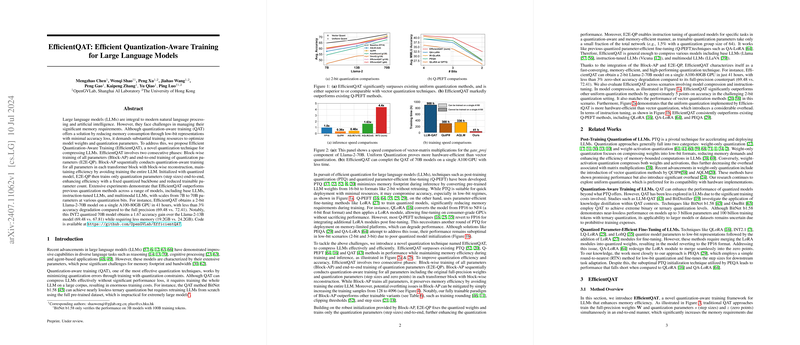EfficientQAT: Efficient Quantization-Aware Training for LLMs
The proliferation of LLMs in various NLP and AI applications has necessitated the development of effective model compression techniques. The paper "EfficientQAT: Efficient Quantization-Aware Training for LLMs" addresses this pressing need by introducing EfficientQAT, a novel quantization-aware training (QAT) methodology designed to optimize LLMs in terms of both memory consumption and training efficiency.
Introduction
LLMs have demonstrated remarkable capabilities in diverse tasks such as reasoning, cognitive processing, and agent-based applications. However, the substantial memory requirements of these models present significant challenges. Traditional QAT algorithms, although effective in memory reduction through low-bit representations, entail considerable training costs. EfficientQAT aims to mitigate these limitations through a methodical two-phase approach: Block-wise training of all parameters (Block-AP) and end-to-end training of quantization parameters (E2E-QP).
Methodology
EfficientQAT comprises two core phases:
- Block-AP: This phase sequentially trains transformer blocks in isolation, applying quantization-aware training to all parameters within each block. This strategy avoids the computational overhead associated with training the entire model end-to-end. By increasing training samples from 128 to 4096, potential overfitting issues are effectively addressed, resulting in improved model initialization.
- E2E-QP: Following Block-AP, this phase focuses exclusively on training the quantization parameters, such as step sizes, while maintaining fixed quantized weights. This approach ensures that the training remains memory efficient and yields high performance by leveraging a quantized backbone.
Experimental Results
Extensive experiments validate the superiority of EfficientQAT over existing quantization methodologies including post-training quantization (PTQ), QAT, and quantized parameter-efficient fine-tuning (Q-PEFT) methods. The significant findings from these evaluations include:
- Model Compression: EfficientQAT exemplifies competitive performance in low-bit quantization scenarios (2-bit and 3-bit), significantly outperforming other uniform quantization methods. For instance, the 2-bit Llama-2-70B model achieved a zero-shot accuracy of 69.48, slightly declining by less than 3% compared to its full-precision version.
- Training Efficiency: EfficientQAT completes the quantization process for a 70B parameter model within 41 hours on a single A100-80GB GPU, underscoring its efficiency in large-scale training environments. Moreover, the optimized memory footprint facilitates training models even on limited hardware resources.
- Inference Speed: Table \ref{fig:inference_speed_comparisons} in the original paper highlights a 2.9x to 4.4x increase in inference speed due to the hardware efficiency of uniform quantization over vector quantization, which introduces considerable computational overhead.
Implications
Practically, EfficientQAT extends the feasibility of deploying LLMs in memory-constrained environments without significant performance degradation. The ability to train efficiently on a single GPU presents opportunities for broader accessibility and application of state-of-the-art LLMs. Theoretically, the methodology opens new avenues for further research on refining quantization techniques to balance trade-offs between memory efficiency, training time, and model performance.
Conclusion
EfficientQAT offers a blend of innovative training techniques and practical efficiency for the quantization of LLMs. By focusing on a structured two-phase training framework, this method presents a significant step forward in the domain of efficient LLM optimization. Future research could explore additional refinements in quantization parameters and extend the robustness of EfficientQAT across varied NLP tasks and model architectures. The implications of this work underscore the potential of making sophisticated AI models more accessible and deployable in real-world, resource-constrained environments.
